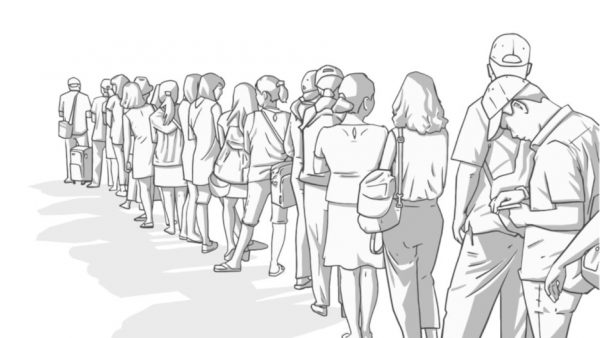By: Bernard Wolfsdorf
A silver lining exists for some immigrants due to the COVID-19 global pandemic. With most U.S. consulates closed or limited to emergency visa processing, there will be many more employment based (EB) immigrant visas available in Fiscal Year (FY) 2021 which starts on October 1, 2020.
The Immigration and Nationality Act provides that if the full quota of family-based visas is not used in any fiscal year, then the unused numbers are added to next year’s employment-based immigration quota. The October 2020 Visa Bulletin indicates that the employment-based quota will be 261,500 – almost double the usual annual quota. This is all-time high – as opposed to the usual 140,000 visas. With U.S. Consulates operating at minimum capacity together with Presidential Proclamations suspending most family-based immigrant visas – there has been a huge “spillover” of at least 120,000 visas available in FY 2021. EB-5 gets 7.1% of those. So, in addition to the normally allocated 10,000 visas, the EB-5 category will get at least 8,566 extra visas for a total of around 18,566 visas.
These additional visas, together with future unused visas resulting from the November 21, 2019 Modernization regulations that increased the minimum investment to $900,000 for Targeted Employment and Rural areas, could substantially change the EB-5 industry that has thrived primarily because of Chinese applicants that previously made up over 80% of all investors. Recent estimates as to the Chinese EB-5 waiting line for new Chinese applicants have been as high as 16 years from filing for new cases. However, if demand for visas by nationals from other countries has shrunk due to the increase in the minimum investment amount, together with long Form I-526 processing times, the number of “leftover” visas that go to those waiting in line the longest, could shorten the estimates to as little as 8 years for new Form I-526 petition filings by Chinese.
These two facts, that is, the almost double FY2021 quota, together with the surge in likely unused “rest of the world” or ROW visas, will provide the best ever year for China visa issuance and give “hope” to an industry starved by lack of visas.
This author has repeatedly emphasized that no one knows the actual waiting line because there are too many variables.
However, we do know that demand for EB-5 visas since the increase in the minimum investment amount has slowed down to a trickle. During the second quarter of FY 2020, which is the first reported period after the increase of the minimum investment amount from $500,000 to $900,000, only 21 cases were filed. While this will increase as investors adjust to the new investment amount, it is likely that most of the future annual 10,000 visa annual allocation (other than for India and Vietnam) will go to the China backlog cases.
| FY2020 Q2 Data | ||||
| Form | Receipts | Approvals | Denials | Pending |
| I-526 | 21 | 714 | 190 | 16,633 |
Whereas previously the State Department estimated that China would only get about 3,000 “leftover” ROW visas, because of increase in investment amount, these leftover ROW visas will surge, to at least double this amount to 6,000 visas.
With the increased FY2021 quota of about 1,300 visas (the annual per-county limit is 7% of the total 18,566 EB-5 allocation) for each country, China will receive its quota of 1,300, plus all the unused visas because backlogged Chinese applicants have the earliest priority dates, less the 2,600 total for Vietnam and India nationals.
18,566-2,600=15,966 less estimate worldwide usage for all other countries (at maybe 2,500 cases) means China could get 13,466 visas in FY2021.
The unused family visas, together with the drastic reduction in filings, means the EB-5 visa waiting line for mainland-Chinese investors will come down dramatically.

- Fact – USCIS reported that, as of April 20, 2020, there were 23,511 approved Form I-526s filed by mainland-China EB-5 investors awaiting visa availability. This only refers to principal investors and does not include derivative beneficiaries. See chart above. Calculating at the multiplier rate of 2.7 for Chinese derivatives (spouses and children) this means that there are likely about 63,889 future Chinese visa applicants at the stage of having I-526 approval, but not yet able to proceed to final action in the visa process.
- Fact – In June 2020, Charles Oppenheim, Chief of the Visa Controls and Reporting Division at the U.S. Department of State, noted there were 42,575 EB-5 visa applications on file for mainland-China. This number includes both principal investors and derivative beneficiaries. This number appears low, so we have added another 10,000 Chinese applicants just to be conservative.
- Fact – With the increase in the minimum investment amount, there are fewer investors from other countries who will be able to apply for an immigrant visa, increasing the number of “leftover” EB-5 visas that would be available to mainland-China investors with earlier priority dates. See FY2020 Q2 Data above. 18,566-2,600=15,966 less estimated worldwide usage for all other countries at maybe 2,500 cases means China could get 13,466 visas in FY2021.
- Note – While no-one can predict the exact number of unused visas in the future beyond FY2021, because there are too many variables, if rest of the world demand continues to be low, China could get as many as 6,000+ visa per year (10,000-1,400 for India and China and maybe 1,600 for ROW if demand picks up).
- Current number of Chinese nationals waiting for EB-5 green cards between 42,575 (DOS number) and 63,889 (Guestimate based on number of approved petitions).
- Possible total number of green cards to be issued in FY2021 ending September 2021 = 18,566 (adding unused family quota)
- 63,899 less the potential 13,466 FY2021 quota for Chinese nationals = 50,433 Chinese Remainder Cases
- Possible number of green cards to be issued in FY2022 ending September 2022= 6,000 (10,000-4,000 usage), meaning 44,433 Chinese Remainder Cases
- Possible number of green cards to be issued in FY2023 ending September 2022=6,000, meaning 38,433 Chinese Remainder Cases
- Possible number of green cards to be issued in FY2024 ending September 2023=6,000, meaning 32,433 Chinese Remainder Cases
- Possible number of green cards to be issued in FY2025 ending September 2024=6,000, meaning 26,433 Chinese Remainder Cases
- Possible number of green cards to be issued in FY2026 ending September 2025=6,000, meaning 20,433 Chinese Remainder Cases
- Possible number of green cards to be issued in FY2027 ending September 2026=6,000, meaning 14,433 Chinese Remainder Cases
- Possible number of green cards to be issued in FY2028 ending September 2027=6,000, meaning 8,433 Chinese Remainder Cases
- Possible number of green cards to be issued in FY2029 ending September 2028=6,000, meaning 2,433 Chinese Remainder Cases
Total visas available to China in next 9 years = about 60,566
Total current China backlog between 42,575 (DOS Guesstimate) and 63,889 (Author’s Estimate) Based on number of petitions approved.
Based on this guesstimate, a Chinese national filing an EB-5 petition tomorrow could potentially be eligible to obtain a green card in about 7-8 years.
If we use the Department of State Number of 42,575 pending EB-5 applicants less 13,000 for FY2021 = about 30,000 cases left and with 6,000 visas a year going to China, the waiting line for new cases could be only 6-7 years. If we average the number of Chinese cases waiting at about 52,000 (median between low and high estimates) the waiting line for new cases is lower at 6-7 years.
Therefore, Chinese applicants with earlier priority dates may find that with the new $900,000 investment amount, the waiting line will be substantially reduced.
Caution these guestimates do not constitute legal advice in making investment decisions.


